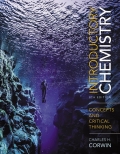
(a)
Interpretation:
Whether the representative particle in methanol is a formula unit or molecule is to be stated.
Concept introduction:
The covalent bond is formed when two non-metals are combined by sharing the valence electrons. The particles that are held together by a covalent bond are known as a molecule. This can be identified when there are two non-metals in an atom.
(b)
Interpretation:
Whether the representative particle in potassium chlorite is a formula unit or molecule is to be stated.
Concept introduction:
In an ionic bond, the cation is attracted to an anion. This attraction is due to the opposite charges on both the ions. The particle that is held together by an ionic bond is known as formula unit. This can be identified when the particle has a metal and a non-metal.
(c)
Interpretation:
Whether the representative particle in manganese
Concept introduction:
In an ionic bond, the cation is attracted to an anion. This attraction is due to the opposite charges on both the ions. The particle that is held together by an ionic bond is known as formula unit. This can be identified when the particle has a metal and a non-metal.
(d)
Interpretation:
Whether the representative particle in acetic acid is a formula unit or molecule is to be stated.
Concept introduction:
The covalent bond is formed when two non-metals are combined by sharing the valence electrons. The particle that is held together by a covalent bond is known as a molecule. This can be identified when there are two non-metals in an atom.
Want to see the full answer?
Check out a sample textbook solution
Chapter 12 Solutions
EBK INTRODUCTORY CHEMISTRY
- Write the formula of the compound that will be formed between these elements: (a) H and F (b) Cs and P (c) Al and Clarrow_forwardWrite a chemical formula for a compound that containstwo chlorine atoms to every one oxygen atom. (a) Cl2O(b) ClO2(c) 2ClO(d) Cl(O2)2arrow_forwardWrite the formulas of the following covalent compounds. (Type your answer using the format CO2 for CO2.) (a) silicon tetrachloride(b) carbon tetrachloride(c) dinitrogen tetroxide(d) dinitrogen oxidearrow_forward
- Elements in the same group of the periodic table often formoxyanions with the same general formula. The anions arealso named in a similar fashion. Based on these observations,suggest a chemical formula or name, as appropriate, for eachof the following ions: (a) BrO4-, (b) SeO32-, (c) arsenate ion,(d) hydrogen tellurate ion.arrow_forwardUsing Lewis electron-dot symbols to depict the monatomic ions formed from each of the following reactants, predict the formula of the compound the ions produce.(Type your answer using the format CO2 for CO2.) (a) O and Ca (b) N and Mg (c) Br and Li (d) K and Parrow_forwardWhich of the following statements are true regarding a covalent bond between nitrogen and oxygen atoms in a nitric oxide, NO, molecule? (a) Valence electrons are shared between nitrogen and oxygen atoms. (b) Bonding electrons are found only between the bonded atoms. (c) The bond length is greater than the sum of the two atomic radii. (d) Energy is required to break a covalent bond.arrow_forward
- Predict which of these compounds are ionic and which are covalent.(A) Ca3N2(B) Li2CO3(C) PCl5(D) NaOH(E) CH4(F) MgOarrow_forwardDetermine whether the following atoms will form an ionic compound or a molecular compound, and give the formula of the compound. (a) 2 bromine (b) carbon and oxygenarrow_forwardWhich of the following compounds has both ionic and covalent bond? (a) H2O (b) NH4Cl (c) NaCl (d) HClarrow_forward
- Based on Linus Pauling's electronegativity scale, would H2S be considered a polar molecule? Pick the best answer. (a) No. It would technically be considered a non-polar molecule. (b) No. Even though it contains polar bonds they are symmetrical and therefore H2S is non-polar. (c) No. The electronegativity difference between H and S is so great that it would be considered an ionic compound. (d) H2S violates the octet rule and therefore would not even existarrow_forwardWrite formulas for ionic compounds. (a) What is the formula of the ionic compound expected to form between the elements sodium and fluorine? (b) What is the formula of the compound formed between the ions Co²+ and SO₂²? (c) What ions make up the ionic compound Zn(CN)₂? Cation formula Anion formulaarrow_forwardElements in the same group of the periodic table often form oxyanions with the same general formula. The anions are also named in a similar fashion. Based on these observations, suggest a chemical formula or name, as appropriate, for each of the following ions: (a) BrO4 -, (b) SeO3 2-, (c) arsenate ion, (d) hydrogen tellurate ion.arrow_forward
 Introduction to General, Organic and BiochemistryChemistryISBN:9781285869759Author:Frederick A. Bettelheim, William H. Brown, Mary K. Campbell, Shawn O. Farrell, Omar TorresPublisher:Cengage Learning
Introduction to General, Organic and BiochemistryChemistryISBN:9781285869759Author:Frederick A. Bettelheim, William H. Brown, Mary K. Campbell, Shawn O. Farrell, Omar TorresPublisher:Cengage Learning
